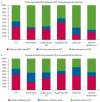Infection and venous thromboembolism in patients undergoing colorectal surgery: what is the relationship?
- PMID: 24608307
- PMCID: PMC4332793
- DOI: 10.1097/DCR.0000000000000054
Infection and venous thromboembolism in patients undergoing colorectal surgery: what is the relationship?
Abstract
Background: There is evidence demonstrating an association between infection and venous thromboembolism. We recently identified this association in the postoperative setting; however, the temporal relationship between infection and venous thromboembolism is not well defined
Objective: We sought to determine the temporal relationship between venous thromboembolism and postoperative infectious complications in patients undergoing colorectal surgery.
Design, setting, and patients: A retrospective cohort analysis was performed using data for patients undergoing colorectal surgery in the National Surgical Quality Improvement Project 2010 database.
Main outcome measures: The primary outcome measures were the rate and timing of venous thromboembolism and postoperative infection among patients undergoing colorectal surgery during 30 postoperative days.
Results: Of 39,831 patients who underwent colorectal surgery, the overall rate of venous thromboembolism was 2.4% (n = 948); 729 (1.8%) patients were diagnosed with deep vein thrombosis, and 307 (0.77%) patients were diagnosed with pulmonary embolism. Eighty-eight (0.22%) patients were reported as developing both deep vein thrombosis and pulmonary embolism. Following colorectal surgery, the development of a urinary tract infection, pneumonia, organ space surgical site infection, or deep surgical site infection was associated with a significantly increased risk for venous thromboembolism. The majority (52%-85%) of venous thromboembolisms in this population occurred the same day or a median of 3.5 to 8 days following the diagnosis of infection. The approximate relative risk for developing any venous thromboembolism increased each day following the development of each type of infection (range, 0.40%-1.0%) in comparison with patients not developing an infection.
Limitations: We are unable to account for differences in data collection, prophylaxis, and venous thromboembolism surveillance between hospitals in the database. Additionally, there is limited patient follow-up.
Conclusions: These findings of a temporal association between infection and venous thromboembolism suggest a potential early indicator for using certain postoperative infectious complications as clinical warning signs that a patient is more likely to develop venous thromboembolism. Further studies into best practices for prevention are warranted.
Figures



References
-
- Alikhan R, Spyropoulos AC. Epidemiology of venous thromboembolism in cardiorespiratory and infectious disease. Am J Med. 2008;121:935–942. - PubMed
-
- Kamphuisen PW, Eikenboom JC, Vos HL, et al. Increased levels of factor VIII and fibrinogen in patients with venous thrombosis are not caused by acute phase reactions. Thromb Haemost. 1999;81:680–683. - PubMed
-
- Semeraro N, Ammollo CT, Semeraro F, Colucci M. Sepsis, thrombosis and organ dysfunction. Thromb Res. 2012;129:290–295. - PubMed
-
- Törngren S, Hägglund G, Molin K, Rieger A. Postoperative deep venous thrombosis and infectious complications: a clinical study of patients undergoing colo-rectal surgery. Scand J Infect Dis. 1980;12:123–127. - PubMed
Publication types
MeSH terms
Grants and funding
LinkOut - more resources
Full Text Sources
Other Literature Sources
Medical

